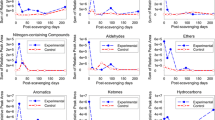Abstract
Leachate, generated by the decomposition of animal carcasses, presents many environmental, sanitary, and food safety hazards. However, research on the characteristics of leachate is lacking. In this study, we performed biochemical profiling of leachate from two animal species (pig and cattle) in two soil types (sandy loam and sandy soil) using 1H-NMR-based profiling, followed by multivariate data analysis. The leachate was collected from a well-controlled artificial burial site over a 31-week period. Principal components analysis (PCA) of the NMR data showed similar patterns between species and soil types. Organic components, including organic acids and phenols, predominated, and their levels increased with time. The methylamine level in leachate from pig carcasses 18 weeks following burial was significantly higher than that from cattle carcasses; leachate from cattle carcasses in sandy soil 1 week after burial contained unique components (specifically ethanol, formate, alanine, N-methylation, and taurine), in contrast with those from sandy loam soil. This study suggests that a NMR-based profiling approach is useful to characterize the organic components in leachate from animal carcasses over time.





Similar content being viewed by others
References
Alexander DJ (2000) A review of avian influenza in different bird species. Vet Microbiol 74:3–13
Beigel JH, Farrar J, Han A, Hayden F, Hyer R, De Jong M, Lochindarat S, Nguyen T, Nguyen T, Tran T (2005) Avian influenza A (H5N1) infection in humans. New Engl J Med 353:1374–1385
Chan PK (2002) Outbreak of avian influenza A (H5N1) virus infection in Hong Kong in 1997. Clin Infect Dis 34:S58–S64
Davies G (2002) Foot and mouth disease. Res Vet Sci 73:195–199
Flory GA, Peer RW, Bendfeldt ES (2006). Evaluation of poultry carcass disposal methods used during an avian influenza outbreak in Virginia in 2002. Virginia Department of Environmental Quality
Glanville TD, Ahn H, Richard TL, Harmon JD, Reynolds DL, Akinc S (2006). Environmental impacts of emergency livestock mortality composting—leachate release and soil contamination. ASABES Annual International Meeting ASABE paper NO. 064049
Glanville TD, Ahn H, Richard T, Shiers L, Harmon JD (2009) Soil contamination caused by emergency bio-reduction of catastrophic livestock mortalities. Water Air Soil Pollut 198:285–295
Graiver DA, Topliff CL, Kelling CL, Bartelt-Hunt SL (2009) Survival of the avian influenza virus (H6N2) after land disposal. Environ Sci Technol 43:4063–4067
Grubman MJ, Baxt B (2004) Foot-and-mouth disease. Clin Microbiol Rev 17:465–493
Guan J, Chan M, Grenier C, Brooks B, Spencer J, Kranendonk C, Copps J, Clavijo A (2010) Degradation of foot-and-mouth disease virus during composting of infected pig carcasses. Can J Vet Res 74:40–44
Kang M, Kim M-S, Choi B, Sohn H-Y (2012) Organic matter analysis and physicochemical properties of leachate from a foot-and-mouth disease landfill site. Korean J Microbiol Biotechnol 40:128–134
Kieny M, Lathe R, Drillien R, Spehner D, Skory S, Schmitt D, Wiktor T, Koprowski H, Lecocq J (1984) Expression of rabies virus glycoprotein from a recombinant vaccinia virus. Nature 312:163–166
Kimberlin RH, Wilesmith JW (1994) Bovine spongiform encephalopathy. Ann N Y Acad Sci 724:210–220
Maher D, Chaulet P, Spinaci S, Harries A (1997). Treatment of tuberculosis: guidelines for national programmes. Treatment of tuberculosis: guidelines for national programmes. Geneva World Health Organization 1-77
Martin FPJ, Wang Y, Sprenger N, Yap IK, Lundstedt T, Lek P, Rezzi S, Ramadan Z, van Bladeren P, Fay LB (2008) Probiotic modulation of symbiotic gut microbial–host metabolic interactions in a humanized microbiome mouse model. Mol Syst Biol 4:157
McGee D (1977) Black leg (Leptosphaeria maculans (Desm.) Ces. de Not.) of rapeseed in Victoria: sources of infection and relationships between inoculum, environmental factors and disease severity. Crop Pasture Sci 28:53–62
Moennig V (2000) Introduction to classical swine fever: virus, disease and control policy. Vet Microbiol 73:93–102
Pratt D, Fonstad T (2009). Livestock mortalities burial leachate chemistry after two years of decomposition, Proceedings of 3rd International Symposium on Management of Animal Carcasses, Tissue and Related Byproducts
Reuter T, Xu W, Alexander TW, Gilroyed BH, Inglis GD, Larney FJ, Stanford K, McAllister TA (2010) Biocontained carcass composting for control of infectious disease outbreak in livestock. J Vis Exp 39:e1946
Smith E, Macfarlane G (1997) Dissimilatory amino acid metabolism in human colonic bacteria. Anaerobe 3:327–337
Swayne D, Suarez D (2000) Highly pathogenic avian influenza. Revue scientifique et technique. Rev Sci Tech 19:463–482
Thauer RK (1998) Biochemistry of methanogenesis: a tribute to Marjory Stephenson: 1998 Marjory Stephenson Prize Lecture. Microbiol 144:2377–2406
Topping DL, Clifton PM (2001) Short-chain fatty acids and human colonic function: roles of resistant starch and nonstarch polysaccharides. Physiol Rev 81:1031–1064
Varel VH (2002) Carvacrol and thymol reduce swine waste odor and pathogens: stability of oils. Curr Microbiol 44:38–43
Warner MA, Harper JV (1985) Cardiac dysrhythmias associated with chemical peeling with phenol. Anesthesiology 62:366–367
Yoo HS (2011) Foot and mouth disease: etiology, epidemiology and control measures. Infect Chemother 43:178–185
Acknowledgments
This study was supported by a grant from the Korea Basic Science Institute (C34705) and the National Research Foundation of Korea Grant funded by the Korean Government (MSIP) (2013, University-Institute cooperation program).
Author information
Authors and Affiliations
Corresponding author
Additional information
Responsible editor: Philippe Garrigues
Yong-Kook Kwon and Hyun-Whee Bae contributed equally to the work.
Rights and permissions
About this article
Cite this article
Kwon, YK., Bae, HW., Shin, S.K. et al. 1H-NMR-based profiling of organic components in leachate from animal carcasses disposal site with time. Environ Sci Pollut Res 21, 10453–10460 (2014). https://doi.org/10.1007/s11356-014-2992-7
Received:
Accepted:
Published:
Issue Date:
DOI: https://doi.org/10.1007/s11356-014-2992-7




